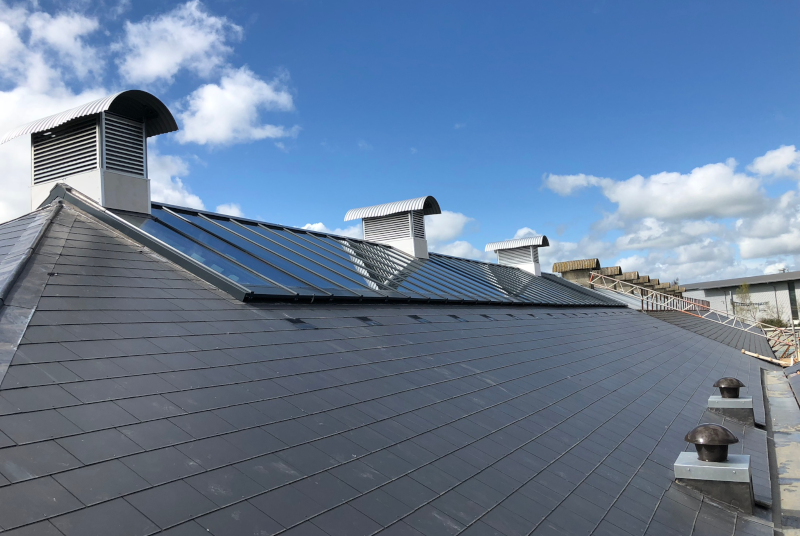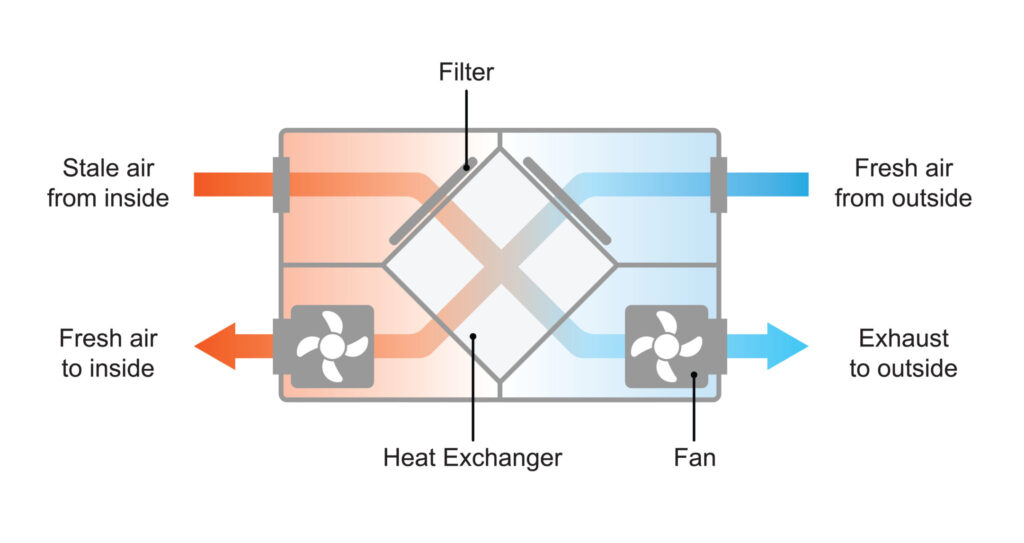With rising global temperatures and the need to minimise energy consumption, it’s vital that we implement sustainable HVAC solutions. Whilst natural ventilation is the most energy efficient form of ventilation, this on its own it isn’t appropriate for all building types and locations. Mixed-mode ventilation (also called hybrid ventilation) can be an effective solution in creating comfortable, healthy, high-performing buildings of various types.

Ventilation Design
Designing an effective ventilation strategy for a building is fundamental for the health and wellbeing of its occupants. Suitable ventilation ensures comfort, supports concentration and productivity, deals with potentially harmful pollutants like air-borne viruses, and protects the building fabric from the negative impacts of humidity.
The amount of ventilation required will depend on building type (residential, office, school etc), how it’s used and the number of occupants day-to-day. Additional factors like solar heat gains and thermal mass also play a role, as they impact upon internal temperatures. Building regulations which also guide ventilation strategy in England (Approved Document F) state the required number of internal air changes per hour to ensure healthy building conditions.
In terms of physical installation, design teams will consider the most appropriate solution for the project by assessing all the above factors.
Mixed-mode ventilation is an approach which combines natural and mechanical ventilation systems, using one to support the other and combining the benefits of each.
What is Natural Ventilation?
Natural ventilation (also called passive ventilation) utilises openings in a building’s fabric, like windows, to allow fresh air from outside to enter and circulate. This works due to differences in air pressure; wind pressure difference across the building, and the natural buoyancy of warm air, cause stale indoor air to be expelled, whilst fresh (cooler) air from outside is drawn in.
Natural ventilation offers energy savings, environmental sustainability, and low maintenance, and is helpful for diluting indoor pollutants and odours. But this method is not effective in preventing external pollutants like fumes and noise from entering, which can compromise indoor comfort and air quality. The elements of wind speed, direction and temperature are also not controlled, leading to inconsistent indoor conditions and potentially uncomfortable environmental conditions.
What is Mechanical Ventilation?
Mechanical ventilation utilizes mechanically powered fans and duct systems to circulate and exchange indoor air with outdoor air. Modern units typically include heating, cooling, and air filtering features to enhance indoor air quality, remove pollutants and regulate temperature. MVHR (Mechanical ventilation with heat recovery) for example recovers the heat from outgoing air and uses it to warm incoming air to a comfortable temperature.

However, discomfort can occur in spaces that are only mechanically ventilated if the system is not properly managed, and with no option to open windows. Issues such as cost, maintenance, high energy usage, and noise from the unit, should all be considered when designing a ventilation plan.
Mixed-mode Ventilation: the best of both?
By harnessing natural airflow and integrating regulatory mechanical features, hybrid ventilation can offer both energy efficiency and environmental control. Benefits include:
- Managing overheating/overcooling risk: Whilst natural ventilation is ideal in terms of energy savings, overheating risks need to be carefully assessed and managed, especially in the light of climate change. Integrating mechanical ventilation supports better regulation of indoor conditions to avoid surpassing temperature thresholds (CIBSE’s TM52 standards state that during warmer months indoor temperature must not exceed the maximum threshold comfort temperature (Tmax) by 1C for more than 3% of occupied hours). In terms of cooling, introducing cooler fresh air via natural ventilation reduces the need for mechanical air conditioning, whilst mechanical features can step in to avoid overcooling by regulating airflow (for example automatically closing air vents or windows).
- Consistent air quality: As well as temperature, mechanical systems regulate humidity and CO2 levels. Natural ventilation helps to circulate fresh air, whilst mechanical systems monitor air quality via sensors and will increase or reduce the amount of natural ventilation where needed. This further helps to create comfortable internal environments.
- Sustainability: A mixed-mode system relies less upon energy consuming mechanical units. It therefore has lower environmental impact than a fully mechanical system and can support a long-term sustainable building strategy.
- Reduced energy bills: Less energy consumption reduces overall running costs, compared with if the building was only mechanically ventilated.
- Adaptability and Responsiveness: mixed-mode ventilation offers flexibility by allowing occupants to select natural and/or mechanical ventilation modes based on influences such as weather, indoor air quality, and occupancy levels.
What are the challenges of a mixed-mode system?
All ventilation design benefits from a holistic approach, understanding how a building will breathe. Creating a precise and interconnected mixed-mode ventilation system can pose challenges. These include:
- Building fabric: Coordinating the size, number and location of ventilation openings along with the installation of mechanical ventilation units and ducts, can add complexity. In a refurbishment or listed building for example, it may not be possible to alter the building fabric or create any additional openings, so the system needs to work with or adapt what is already existing.
- Cost: Whilst the hybrid approach can reduce a building’s running costs, integrating both natural and mechanical features could increase construction costs compared with naturally ventilation only, but is typically less expensive than buildings with traditional mechanical ventilation and air conditioning systems.
The future of ventilation
Mixed-mode ventilation is not new, but increasing innovation in ventilation and smart building technologies means the scope for energy efficient and user-friendly systems is very positive. Where such a system is appropriate, a well-designed and efficient mixed-mode ventilation system can offer long-term benefits in the creation of healthy, comfortable and sustainable buildings. It is therefore best to consider the ventilation strategy as early as possible in a project, to ensure the best possible outcome.
As building services consultants and sustainable engineering specialists, P3R Engineers have designed successful mixed-mode ventilation systems for a variety of buildings. Among them are ArtsEd, Young V&A and Swindon Carriage Works. We have created highly efficient, innovative and bespoke air handling solutions, designed to co-ordinate with overall building aesthetic and historical architectural features.
If you would like to discuss your project, please get in touch with our team.